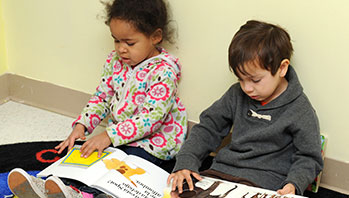- browsing boxes or bins
- including several versions of the The Three Little Pigs
- different
- favorite
- same
- version
MA Standards:
English Language Arts/Foundational Skills/RF.PK.MA.1.a Handle books respectfully and appropriately, holding them right-side-up and turning pages one at a time from front to back.
Head Start Outcomes:
Literacy Knowledge/Book Appreciation and Knowledge Shows interest in shared reading experiences and looking at books independently.
Literacy Knowledge/Book Appreciation and Knowledge Recognizes how books are read, such as front-to-back and one page at a time, and recognizes basic characteristics, such as title, author, and illustrator.
Social Emotional Development/Self-Concept and Self-Efficacy Identifies personal characteristics, preferences, thoughts, and feelings.
Social Emotional Development/Self-Concept and Self-Efficacy Demonstrates age-appropriate independence in a range of activities, routines, and tasks.
Social Emotional Development/Self-Concept and Self-Efficacy Shows confidence in a range of abilities and in the capacity to accomplish tasks and take on new tasks.
PreK Learning Guidelines:
English Language Arts/Reading and Literature 10 Engage actively in read-aloud activities by asking questions, offering ideas, predicting or retelling important parts of a story or informational book.
Health Education 19 Practice independence and self-help skills.
EEC Infant and Toddler Guidelines
PW45. The older toddler develops self-help skills.
Independent and Partner Reading, Unit 6, Week 3

© Commonwealth of Massachusetts, Department of Early Education and Care (Jennifer Waddell photographer). All rights reserved.
Skill Focus: Book Appreciation, Listening and Speaking, Making Connections, Vocabulary
Fill a book-browsing box with several versions of The Three Little Pigs story. Encourage children to identify and choose their favorite version of The Three Little Pigs, and allow them to read the book alone or with a partner. As children read, ask them to tell you why it is their favorite.
After reading, ask children questions to help them compare the version to others they have read. For example, ask,
- Who are the characters in this version?
- How are the houses like or different from those in other versions?
- What happens at the end of this story?
Encourage children to answer the questions by browsing through the pages and pointing to the pictures.
